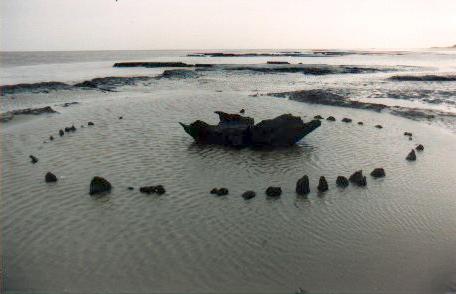
In 1998, tides exposed a ring of Bronze Age timbers off the coast of Norfolk.
The monument appears to have been created in 2049 B.C., probably in a salt marsh that was later overrun by the sea.
What was its purpose? Who knows?

In 1998, tides exposed a ring of Bronze Age timbers off the coast of Norfolk.
The monument appears to have been created in 2049 B.C., probably in a salt marsh that was later overrun by the sea.
What was its purpose? Who knows?
In 1808, a French gentleman bought 2,700 acres in Georgetown, N.Y., and erected a chateau on the highest hill. Evidently he was massively wealthy, landscaping the grounds extensively and ordering a hamlet built on the estate, after the fashion of the great French nobles. And he seemed fearful for his safety, securing the house against gunfire and clearing the woods around it.
He roved the estate on horseback, attended by armed servants, and was described as erect, agile, and commanding. When asked to muster for the local militia he responded with outrage, saying he had led a division and participated in making three treaties, but he gave no other clues to his identity. He followed closely the progress of the War of 1812 and of Napoleon, whose ascendancy he evidently feared; when the Corsican met disaster in Russia he returned abruptly to France.
Who was this man? He gave his name as Louis Anathe Muller, but he guarded his true identity closely. Was he a French duke? A son of Charles X? The future king himself? With only circumstantial evidence, there’s no way to be certain. After Waterloo he sold the estate for a fraction of its value, and he never returned to New York.

The inventor of the Pringles can was buried in a Pringles can.
Fredric Baur invented the crush-resistant canister in 1966 and was so proud that he said he’d like to be buried in one. It remained a family joke for years, but when Baur died last year after a battle with Alzheimer’s, his children stopped at a Walgreen’s on their way to the funeral home, bought a can of Pringles, and buried a portion of their father’s ashes in the bright red can.
“My siblings and I briefly debated what flavor to use,” Larry Baur told Time magazine, “but I said, ‘Look, we need to use the original.'”
In 1907, Massachusetts physician Duncan MacDougall conceived a singular experiment. When he observed that a patient at his Haverhill hospital was nearing death, he installed him in a specially constructed bed in his office and measured his weight both before and after death. With six such weighings he determined that humans lose between 0.5 and 1.5 ounces at death.
“Is the soul substance?” he wrote. “It would seem to me to be so. … Here we have experimental demonstration that a substance capable of being weighed does leave the human body at death.”
Similar experiments with 15 dogs showed no change in mass, proving, he decided, that dogs have no souls. MacDougall’s findings were written up briefly in the New York Times and occasioned a flurry of correspondence in American Medicine, but after that they were largely forgotten. But who knows? Perhaps he was right.

German illusionist Matthias Buchinger (1674-1740) was born without hands or legs — but he scarcely missed them. Besides being an expert artist, musician, and marksman, Buchinger excelled as a card player and conjuror:
“He used to perform before company, to whom he was exhibited, various tricks with cups and balls, corn, and living birds; and could play at skittles and nine-pins with great dexterity; shave himself with perfect ease, and do many other things equally surprising in a person so deficient, and mutilated by Nature.” (Great and Eccentric Characters, 1877)
Almost unbelievably, in the self-portrait above, engraved with his finlike hands, Buchinger hid seven biblical psalms and the Lord’s Prayer in the curls of his wig.
The thunder storm of Sunday night — the winding up of one of the most oppressive days ever inflicted on mortal man — was really terrific. The whole firmament growled thunder and shot lightning. It was blinding to look out, and at frequent intervals the thunderbolts burst overhead with a power that shook the solidest structures — then rolled with angry growling along the wings of the storm. St. Paul’s church was struck, but not seriously injured. Beyond this, we have heard of no casualty, unless we may account for such the raining down of an alligator about two feet long at the corner of Wentworth and Anson streets. We have not been lucky enough to find any one who saw him come down — but the important fact that he was there, is incontestible — and as he couldn’t have got there any other way, it was decided unanimously that he rained down. Besides the beast had a look of wonder and bewilderment about him, that showed plainly enough he must have gone through a remarkable experience. By the last accounts he was doing as well as an alligator could be expected to do after sailing through the air in such bad weather.
— Charleston Mercury, quoted in Niles’ Weekly Register, July 8, 1843

For years, South African miners have been finding disks and spheres like this one. Usually brown or red, the objects can measure up to 10 centimeters in diameter, and like this one they’re often engraved with parallel grooves or ridges.
How could worked artifacts have found their way into mineral deposits that are billions of years old? Did aliens visit southern Africa in the remote past? Or is the region’s geologic history vastly different than we’d imagined?
Neither. Despite their artificial appearance, geologists say the objects arose naturally, probably as concretions as volcanic sediments in the region hardened into pyrophyllite.
See The Eltanin Antenna.
One of the most enduring contributions to the [Wolfgang] Pauli legend was the ‘Pauli Effect,’ according to which Pauli could, by his mere presence, cause laboratory accidents and catastrophes of all kinds. Peierls informs us that there are well-documented instances of Pauli’s appearance in a laboratory causing machines to break down, vacuum systems to spring leaks, and glass apparatus to shatter. Pauli’s destructive spell became so powerful that he was credited with causing an explosion in a Göttingen laboratory the instant his train stopped at the Göttingen station.
– William H. Cropper, Great Physicists, 2004
(To exaggerate the effect, Pauli’s friends once arranged to have a chandelier crash to the floor when he arrived at a reception. When he appeared, a pulley jammed, and the chandelier refused to budge.)
Doubtful but interesting: I’ve found four secondhand accounts that in December 1827 a planter working in a field near Montevideo discovered a tombstone covered with unknown characters, and that it covered a small excavation containing two rusted swords, a helmet, a shield, and a large earthen vessel.
According to the story, the legible part of the inscription was in Greek: “During the dominion of Alexander, the son of Philip, King of Macedon, in the sixty-third Olympiad, Ptolemais–”
The handle of one of the swords reportedly displayed the portrait of a man, supposedly Alexander the Great, and one of the helmets had been sculpted with the image of Achilles dragging the corpse of Hector around the walls of Troy.
The implication is that the ancient Greeks had reached South America — that a commander in Alexander’s fleet was overtaken by a storm in the Atlantic and driven to the Brazilian coast, where he established a monument to commemorate their presence there.
“The interesting nature of this account is sufficient to make us regret its manifest improbability,” writes the Foreign Review. “Such a discovery in Brazil from the time of Alexander is not likely to receive authentic confirmation.”
(The other accounts are in Josiah Priest, American Antiquities, and Discoveries in the West, 1833; The Native Races of the Pacific States of North America, 1876; and Elroy McKendree Avery, A History of the United States and Its People, 1904.)
A manuscript published at Tortona, Italy, in 1677 tells of a Milanese friar who was killed by a meteorite:
All the other monks of the convent of St. Mary hastened up to him who had been struck, as well from curiosity as from pity, and among them was also the Canon Manfredo Settala. They all carefully examined the corpse, to discover the most secret and decisive effects of the shock which had struck him; they found it was on one of the thighs, where they perceived a wound blackened either by the gangrene or by the action of the fire. Impelled by curiosity, they enlarged the aperture to examine the interior of it; they saw that it penetrated to the bone, and were much surprised to find at the bottom of the wound a roundish stone which had made it, and had killed this monk in a manner equally terrible and unexpected.
Take that for what it’s worth. In modern times meteorites have struck an Alabama woman and a Ugandan boy, but neither was seriously injured. (There’s also a dog story.)